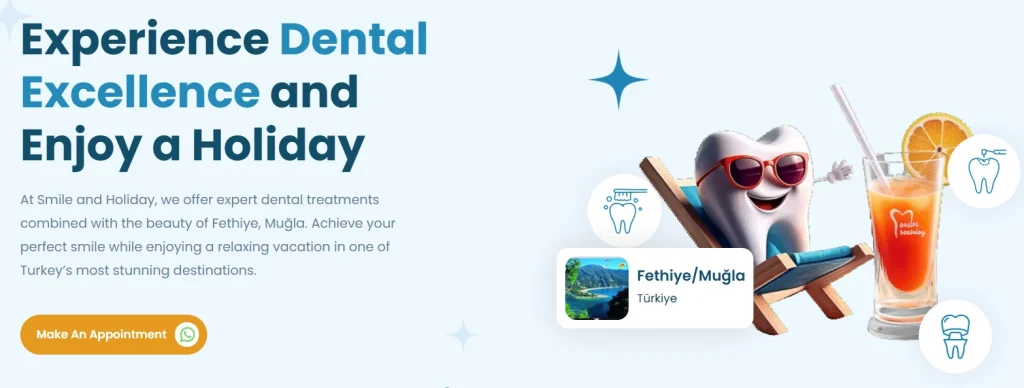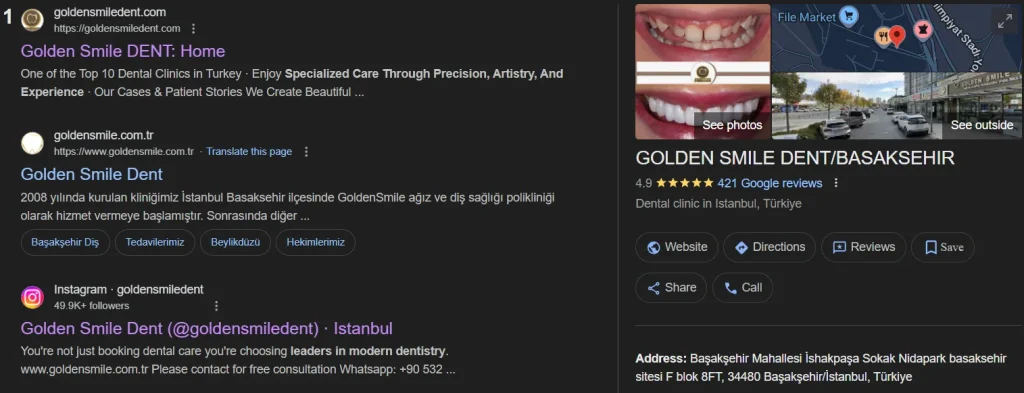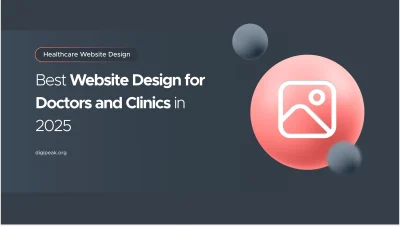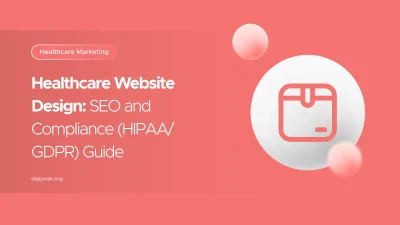
B2B Healthcare Marketing: Viable Medical Business Solutions
The healthcare sector is undergoing a profound digital transformation. For businesses operating in the B2B …
04/09/2025 -
16 dk okuma
Stay up to date with Peakers
today’s competitive dental industry, a polished, optimized website is the cornerstone of attracting new patients. Studies show that roughly 70–80% of prospective patients search for dentists online before booking an appointment, and nearly all of them (over 90%) rely on the internet to find and vet a new dental clinic. If your practice has a weak or outdated online presence, many potential clients will simply move on to the next result. That means a dental website must be professional, user-friendly, and rich in relevant content.
An effective dental website does more than look good – it converts visitors into patients. It answers common questions, highlights services, and makes booking an appointment easy. A responsive clinic website design and fast performance inspire trust, since about 40% of users will abandon a slow site. Mobile compatibility is also crucial: over half of dental searches happen on smartphones, and 57% of users won’t recommend a business with a poorly designed mobile site. Every element – from layout and images to SEO-friendly structure – should work together to guide visitors smoothly to your clinic’s door.
Low Consultation / Appointment Rates?
Increase Bookings with a Free Funnel Review.
We’ll identify drop-off points from click to consultation and recommend fixes that actually convert. Request your free review.
First impressions matter. The moment a potential patient lands on your homepage, your design and branding create an instant sense of trust (or skepticism). Clean, modern layouts with consistent color schemes and professional images build credibility. Dental websites that use a soothing color palette (often blues and whites) and high-quality photos of the clinic, equipment, and smiling staff reinforce a sense of professionalism. Make sure your logo and color scheme are consistent across every page – studies indicate consistent branding can boost conversions by up to one-third.
Clear Calls-to-Action (CTAs): Place visible buttons like “Book Now,” “Request an Appointment,” or “Call Us Today” in prominent locations (top banner, sidebars, and at the end of pages). These CTAs should stand out in a contrasting color and remain in view as users scroll (sticky headers or footers work well). A large button above the fold can double as a booking link or phone link on mobile, making it easy for visitors to convert immediately.

Intuitive Navigation: Organize your menu with clear labels (Home, About Us, Services, Testimonials, Contact, etc.) so visitors find information without guessing. Dropdown menus or section anchors can help users jump to service details or FAQs. About 38% of users pay close attention to navigation links on their first visit, so a logical structure matters.
Responsive and Fast: Ensure your site adjusts seamlessly to phones, tablets, and desktops. Use mobile-friendly layouts (single-column on phone) and test on various devices. Optimize images and enable browser caching to improve load times – a fast site keeps users engaged, while a slow one drives them away. Every extra second of load time can reduce conversions, so aim for a load time under 3 seconds.
A well-designed site not only looks appealing but also keeps users exploring. High-resolution before-and-after photos of treatments, a friendly photo of the dentist or team, and clear contact information on every page all enhance trust. Remember, a visitor’s first impression is often visual: almost 40% of users judge credibility based on design alone.
Your website needs to be found. Search Engine Optimization (SEO) ensures that when someone googles “dentist near me” or “Invisalign [City]”, your clinic is among the top results. Begin with keyword research: find the exact phrases patients use (e.g. “best orthodontist in London,” “dental implants cost near me,” or “pediatric dentist [Area]”). Use tools like Google’s Keyword Planner or free PAA (People Also Ask) research to gather long-tail questions about dental care.
On-Page SEO: Incorporate those keywords naturally into page titles, headers (H1, H2 tags), meta descriptions, and body text. For example, if you offer teeth whitening, create a page titled “Professional Teeth Whitening in [Your City]” and include related terms (“cosmetic dentist,” “whitening treatments,” etc.). Write concise meta descriptions that entice clicks, and ensure each page has a unique, keyword-rich URL (e.g., yourclinic.com/dental-implants rather than a generic number).

Service Pages: Dedicate a page to each major service (e.g., “Dental Implants,” “Children’s Dentistry,” “Root Canal Treatment”). Detail the service benefits, what patients can expect, and include relevant keywords and FAQs. This helps search engines index your pages properly and answers patient queries directly. Including short explainer videos or diagrams can boost engagement and dwell time.
Schema Markup: Add structured data (schema) to your site code to help search engines understand your content. Use DentalBusiness and FAQ schema to highlight your clinic’s name, address, hours, and patient FAQs. Implementing FAQ schema for common questions can even make your content appear in Google’s “People Also Ask” boxes, increasing visibility.
Blog Content: Regularly publish blog posts or articles that address patient questions and dental health topics (e.g., “How Often Should You Change Your Toothbrush?”, “Signs You Need a Dental Checkup”, “Top 5 Myths About Braces”). This content targets additional keywords and establishes your clinic as an authority. Quality blog content can drive traffic and earn backlinks (we’ve seen blogs generate up to 55% more site visits). Use each post to answer a question clearly (ideal for voice search and PAA snippets) and always include a call-to-action linking to relevant service pages or contact info.
By building content around patient needs and search intent, your site will climb in organic rankings. Always prioritize clarity and usefulness over keyword stuffing; search engines reward user-focused content that actually solves problems. And update your content periodically to keep it current – fresh, accurate pages help maintain rankings and visitor trust.
For healthcare sites, expertise and trustworthiness are paramount. Google’s guidelines for YMYL (Your Money or Your Life) content emphasize E‑A‑T (Expertise, Authoritativeness, Trustworthiness). On your site, demonstrate these qualities:
Expert Authorship: Whenever possible, have dental professionals write or review your content. For example, a blog on “What to Expect During a Root Canal” could be authored by an endodontist at your clinic. Include the author’s credentials or even link to a short bio. This signals to both users and search engines that the information is credible.
Patient-Centered FAQs: Use a dedicated FAQ section to answer common patient questions. Questions can be drawn from your own patient interactions or from Google’s PAA boxes. For instance, “How do I care for my braces?” or “What is an overbite?” By addressing these directly on your site, you improve user experience and may win a spot in search’s quick-answer features.

Regular Updates: Healthcare guidelines change over time. Refresh content every 6–12 months, especially on pages about treatment procedures or health recommendations. An up-to-date site signals authority.
High-Quality Media: Enrich text with images and videos. Before-and-after photos of smile makeovers or a short tour video of the office can engage visitors. All images should have descriptive alt text (which also helps SEO). However, keep media sizes optimized to avoid slowing down the page.
Creating content isn’t just about filling pages – it’s about building authority and trust. Patient testimonials, case studies, and even behind-the-scenes posts (e.g., “Meet Our Hygienists” with bios) add authenticity. Each piece of content should have a clear purpose: to educate, reassure, or motivate the patient to take the next step. Over time, this positions your clinic as a go-to resource for oral health information in your community.
Dental searches are overwhelmingly local (e.g. “dentist near me,” “family dentist in [Town]”). To capture this traffic, focus on Local SEO:
Google Business Profile (GBP): Claim and fully complete your GBP listing. Use the correct business name, address, and phone number (NAP) exactly as on your website. Choose appropriate categories (“Dental Clinic,” “Cosmetic Dentist,” etc.), and fill in hours, services offered, and a compelling business description. Add high-quality photos of your office and team – practices with photos receive 42% more requests for directions and 35% more clicks through to their website.
Reviews on GBP: Encourage satisfied patients to leave a Google review (you can send follow-up emails with a direct link to your review form). A steady stream of positive reviews not only builds trust, but Google also uses review quantity and rating in local rankings. Respond graciously to all reviews (positive or negative) to show you care. Remember that roughly 80% of people trust online reviews as much as personal recommendations, so displaying five-star ratings can sway new patients.
Local Directories and Citations: List your practice on other directories like Yelp, Healthgrades, Zocdoc, and local Yellow Pages (and NHS choices or local equivalents if in the UK). Make sure the NAP information is consistent everywhere. Discrepancies can confuse both patients and Google, hurting your local rank. Directory mentions and backlinks from these sites help boost your authority too.
Local Keywords & Content: Mention your city or neighborhood throughout your site (e.g., “Providing family dentistry in Springfield”). Consider creating content relevant to the local community (like a blog on “Best Dental Care for Families in Downtown Springfield”). Also, embed a Google Map on your Contact page so people see your exact location.
Optimizing for local search means that when someone nearby searches for a dentist, your clinic is more likely to appear in Google’s Local Pack (the map results) or top organic listings. Since 86% of potential patients check Google Maps before choosing a business, a strong local presence is essential to capture that traffic.
Online reputation is crucial. Patient testimonials and reviews on your website and Google profile act as powerful social proof. According to industry data, over 80% of patients trust feedback from other patients, and 90% of consumers trust word-of-mouth from people they know. Displaying genuine reviews on your site can significantly boost credibility.
Create a dedicated “Testimonials” or “Reviews” page featuring quotes from happy patients. If permitted, include first names, images, or even video testimonials to make them authentic. Highlight star ratings and summary results (e.g., “4.9 average from 200+ reviews”) to catch the eye. On high-traffic pages like the homepage or services pages, you might feature a carousel or snippets of reviews with a link to read more.
Collecting patient feedback is not just for marketing – it also improves your services. Over time, managing and showcasing reviews will reinforce trust. Remember: if a visitor sees glowing reviews on your site and Google profile, they’re far more likely to choose your clinic over one with a blank or negative reputation.
A website’s technical health is just as important as its content. Patients expect quick, seamless experiences.
Speed and Hosting: Use a reliable web host and consider a Content Delivery Network (CDN) if you serve wide geographic areas. Compress images and enable browser caching. Test your site’s speed with tools like Google PageSpeed Insights – aim for a load time of 2–3 seconds or less. Slow sites not only frustrate users (50% will abandon after 3 seconds), but Google also ranks fast sites higher.
Mobile & Accessibility: Ensure your site is fully responsive. On mobile, phone numbers and contact buttons should be click-to-call. For accessibility, follow WCAG guidelines: use legible fonts, sufficient color contrast, and alt text for images. For U.S. clinics, also consider HIPAA compliance (secure patient forms and encrypted data transmission). A secure site (HTTPS) with an SSL certificate is non-negotiable; visitors trust that little padlock icon, and browsers flag insecure sites as “Not Secure.”
Clean Technical Setup: Use SEO-friendly URLs (avoid long strings of numbers). Implement an XML sitemap and robots.txt so search engines can crawl your content. Regularly check for broken links or missing pages (404 errors) – a site audit tool can automate this. If you notice any errors, fix them promptly to maintain user trust and SEO health.
Structured Data & Rich Snippets: We mentioned FAQ schema earlier; also use LocalBusiness markup to feed your address, hours, and phone to Google. If applicable, mark up things like service offerings or pricing. These snippets can enhance your search result listing.
Ultimately, a technically sound website keeps users engaged and impresses search engines. Fast, secure, and well-structured sites provide a better user experience and improve SEO performance. It’s worth investing in a skilled web developer to address these aspects if you don’t have the expertise in-house.
Modern patients appreciate convenience. To meet this expectation, integrate online appointment scheduling and automation tools on your site. Interestingly, only about a quarter of dental practices currently offer online booking – adding it could set you apart.
Online Booking System: Embed a booking widget or connect to your practice management software so visitors can see available times and schedule appointments directly. Place “Book Online” links or widgets prominently on the homepage and service pages. Offering this 24/7 accessibility can capture leads who found you outside office hours.
Live Chat or Chatbots: Adding a chat feature allows visitors to ask quick questions (“Do you accept my insurance?”, “How much is a cleaning?”) and get immediate answers. AI chatbots have become popular – one report noted up to a 15% traffic increase after adding an AI assistant. Even a simple messaging tool can improve engagement and reduce bounce rates.
Automated Reminders: Implement email or SMS reminders for upcoming appointments. Practices using automated reminders often see over 80% recall rates. This reduces no-shows and keeps your schedule full. You can also use automation to send follow-up satisfaction surveys or post-op instructions, further enhancing patient care.
These features go beyond marketing – they streamline the patient journey and improve satisfaction. From a marketing perspective, they also increase conversions; for example, clear next steps (like “Book Now”) help move a website visitor from browsing to becoming a booked patient. Make sure any third-party tools you use are mobile-friendly and secure.
Digital marketing is an ongoing process. Use analytics to see what’s working and where to improve.
Set Up Analytics: Install Google Analytics and Google Search Console on your site. Track key metrics like organic traffic, bounce rate, and time on page. Create conversion goals (e.g., form submissions, phone clicks) to see which traffic sources lead to appointments. Regularly review these reports to spot trends.
Track Keywords and Rankings: Use a keyword tool or your Search Console data to monitor how your target keywords are ranking. If you notice drop-offs, you may need to refresh content or build new backlinks. Adjust your keyword focus based on what’s driving qualified traffic (for instance, if “family dentist [City]” is sending more visitors, create more content around family dentistry).
A/B Testing: Experiment with different headlines, button colors, or page layouts. For example, test a red vs. blue “Schedule Appointment” button or a long homepage vs. a concise one-page design. Over time, iterative testing can boost conversion rates.
Monitor Local Listings: Keep an eye on your Google Business insights. It shows how many people found you via search or maps and what actions they took (calls, clicks). Use this data to tweak your listing – maybe more people call on weekends, suggesting extended hours might help.
Stay Current: SEO and healthcare marketing trends evolve. For example, voice search is on the rise; ensure your content answers natural language questions. Google is also using more AI in search (like Google Discover or SGE), so concise answers on your site can win featured snippets. Plan to audit your website every few months to update information, add new content, and optimize underperforming pages.
Consistent measurement ensures you don’t waste effort on tactics that don’t move the needle. By refining your approach based on real data, your dental practice can continually improve its online visibility and patient acquisition cost-effectively.
Whether your practice is in the US, UK, UAE, or elsewhere, these website marketing principles apply with local twists. For example, UK dentists might emphasize NHS availability or private treatment pricing on their site, while US dentists may highlight insurance networks accepted. In the UAE or other regions, consider including multilingual support (such as Arabic and English) and optimizing for region-specific directories.
Cultural factors matter too: for instance, Middle Eastern patients often rely heavily on WhatsApp, so integrating a WhatsApp chat link can boost engagement. Additionally, comply with local regulations: HIPAA and ADA in the US, GDPR in the EU, and any local healthcare laws. But the core remains the same: a secure, SEO-optimized website with valuable content will help any dental clinic stand out.
An optimized website is your practice’s most powerful marketing asset. By focusing on user-friendly design, robust SEO, local presence, and trust-building content, independent dental clinics can significantly expand their patient base. Remember, SEO is a long game – rankings and reputation don’t improve overnight, but consistent effort yields enduring results.
Key takeaways: conduct thorough keyword research; build a responsive, fast site with clear CTAs; create authoritative, patient-focused content (blogs, FAQs, service pages); optimize for local search (Google Business, directories, reviews); showcase social proof; and use analytics to iterate.
By applying these strategies, your dental clinic can capture more local search traffic, win patient trust, and ultimately convert more website visitors into loyal patients. For help implementing any of these tips, consider partnering with an experienced healthcare digital marketing team. Together, you can ensure your website not only looks great but becomes a lead-generating hub that keeps your appointment book full.
Get an Offer


Join Us So You Don't
Miss Out on Digital Marketing News!
Join the Digipeak Newsletter.
Related Posts

The healthcare sector is undergoing a profound digital transformation. For businesses operating in the B2B …

As more patients turn to Google and smartphones for health information, a clinic’s website design …

Healthcare websites serve as a digital marketing front door for practices and hospitals, so they …

In today’s healthcare landscape, effective medical marketing, aka healthcare marketing, is crucial for clinics and …